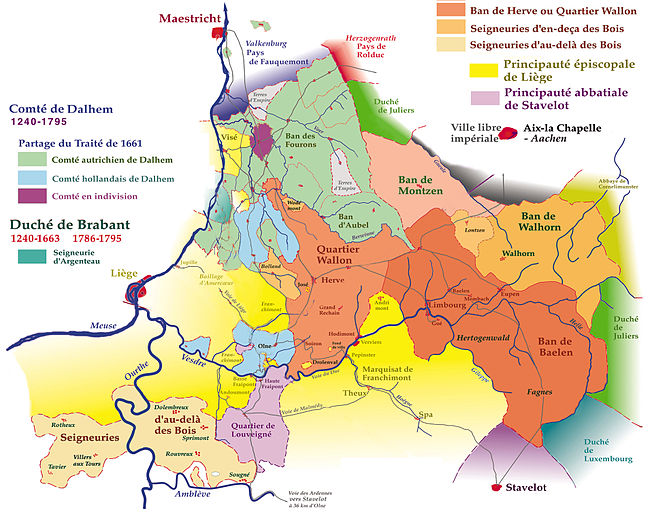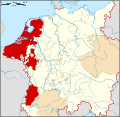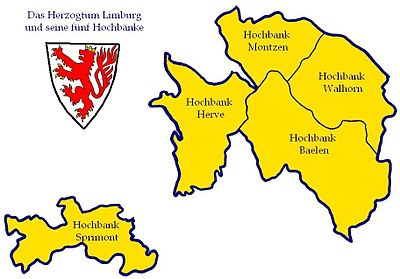- Duchy of Limburg
-
This article deals with the Imperial state of Limburg, for the re-established state of the German Confederation see Duchy of Limburg (1839–1867).
Duchy of Limburg
Herzogtum Limburg (de)
Duché de Limbourg (fr)
Hertogdom Limburg (nl)State of the Holy Roman Empire ← 
1065–1794  →
→Coat of arms
The duchy of Limburg between the Prince-Bishopric of Liège, Aachen and the Duchy of Jülich(1477) Capital Limbourg Language(s) Limburgish, Low Dietsch, Walloon Religion Roman Catholicism Government Monarchy Duke - 1065–82 Waleran I, Count of Limburg - 1082–1119 Henry I, Duke of Limburg and Lower Lorraine - 1288–94 John I, Duke of Brabant, Limburg and Lothier - 1494–1506 Philip III, Duke of Burgundy, King of Castile–León etc - 1792–1794 Francis I, Duke of Lorraine, Holy Roman Emperor etc Historical era Middle Ages - Established 1065 - Passed to Brabant June 5, 1288 - Passed to Burgundy 1406 - Peace of Westphalia 1648 - Treaty of Utrecht 1713 - Annexed by France 1794 The Duchy of Limburg, situated in the Low Countries between the river Meuse and the city of Aachen, was a state of the Holy Roman Empire. Its territory is now divided between the Belgian provinces of Liège (northeastern part) and Limburg (for example Voeren and Rekem), the Dutch province of Limburg (southern part), and a small part of North Rhine-Westphalia in Germany (for example Herzogenrath).
Its most important cities were Limbourg, the capital, and Eupen. Linguistically Limburg was situated on the border of Germanic with Romance Europe. While in the northern and eastern districts Limburgish and Ripuarian dialects were spoken, the southwestern part around Herve was dominated by Walloon.
 A map showing the Duchy and its parts. Parts of the map which did not belong to the Duchy include the yellow parts, which belonged to Liège, and the purple parts, belonged to Stavelot.
A map showing the Duchy and its parts. Parts of the map which did not belong to the Duchy include the yellow parts, which belonged to Liège, and the purple parts, belonged to Stavelot.
History
In Roman times, Limburg was at first situated in the Roman province of Gallia Belgica, but the region extending from the Scheldt to the Rhine, was soon split out to become Germania Inferior, with its capital at Cologne, later reorganized as Germania Secunda. Within this area, the future Duchy was within the Civitas Tungrorum, the polity of the Tungri, with its capital at Tongeren. When Julius Caesar first entered this area and took it under Roman control it was inhabited by a group of Belgic Gaulish tribes, the Condrusi, Eburones, Caeraesi, and Paemani, who were referred to collectively as the Germani. They were in contact with both Gaulish and Germanic peoples. The language they spoke is not certain, and it is also not certain to what extent these earlier tribes can be equated to the Tungri, found in this same area only a few generations later, who are generally accepted to be speakers of a Germanic language. (Tacitus says that the Tungri used to be called the Germani and that other uses of the term are based on their old name.)
By late Roman times, the north of Germania Secunda was dominated by new tribes from over the Rhine, eventually coming under the name of Salian Franks, and the east came under the Ripuarian Franks. The Franks a Germanic people, came to dominate the whole of Germania Secunda, but the region of the Duchy of Limburg, being south of the military Bavay-Tongeren-Heerlen-Cologne route remained relatively Romanized. Under the Merovingian and Carolingian dynasties, Frankish rule expanded from the region around Limbourg to cover larger areas, and eventually began to replace roman imperial rule. By the time of Charlemagne, the first Frank to be called an emperor of Rome (in 800 AD), the kings of the Franks had come to be recognized as heirs to the Western Roman empire. In the time of Charlemagne's grandsons (in 843 AD), the empire came to be divided into three sections, an western Romanized one corresponding very roughly to later France, an eastern part, corresponding very roughly to Germany, and a central one, Lotharingia, later referred to as Lorraine, which was eventually absorbed into the eastern empire. The Duchy of Limburg, like most of modern Belgium, was within Lower Lorraine. For a while, Lower Lorraine had its own single Duke.
The territory of the duchy of Limburg was formed in the 11th century around the town of Limbourg in present-day Wallonia. About 1020, Duke Frederick of Lower Lorraine, a descendant of Count Palatine Wigeric of Lotharingia, had Limbourg Castle built on the banks of the Vesdre river. His estates then comprised the districts of Baelen (with Limbourg), Herve, Montzen (since 1975 part of Plombières), Walhorn, and the southwestern exclave of Sprimont. They were inherited by Frederick's son-in-law Count Waleran of Arlon, who about 1065 began to call himself a "count of Limburg". Waleran also claimed Frederick's ducal title, which was finally acknowledged by Emperor Henry IV in 1101 in favour of Waleran's son Henry. This meant that Lower Lorraine now had two Duchies, that of Brabant, and that of Limburg, and the title of Duke of Lothier, still held by Brabant, eventually became ineffective.
As the Lorrainian ducal dignity was contested by the mighty Counts of Leuven, landgraves of Brabant, Waleran's descendants confined themselves to a "duke of Limburg", and reached the confirmation by Emperor Frederick Barbarossa in 1165. The rise of the Limburg dynasty continued, when Duke Waleran III in 1214 became Count of Luxembourg by marriage with the heiress Ermesinde and his son Henry IV in 1225 became Count of Berg as husband of heiress Irmgard.
However, upon the death of Henry's son Waleran IV in 1279, leaving only one heiress Irmgard, who had married Count Reginald I of Guelders but died childless in 1283, the War of the Limburg Succession broke out. The Duke of Brabant won the final Battle of Worringen in 1288, thereby gaining control of the Duchy of Limburg with the consent by King Rudolph I of Germany. Though it shared the fate of Brabant, Limburg remained a separate Imperial State, which in 1404 passed from Joanna of Brabant to Anthony of Valois, son of the Burgundian duke Philip the Bold. With the Burgundian heritage of Mary the Rich, it was bequested to her husband Maximilian I from the Austrian House of Habsburg in 1482. Combined with the Landen van Overmaas (the lands beyond the Meuse: Dalhem, Herzogenrath and Valkenburg) and Maastricht, the duchy became one of the Seventeen Provinces held by the Habsburgs within the Burgundian Circle established in 1512. Significant towns in Limburg proper were Herve, Montzen, Lontzen, Eupen, Baelen and Esneux.
After the abdication of Emperor Charles V in 1556, the Burgundian fiefs were bequested to his son King Philip II of Spain. The stern measures of the Council of Troubles implemented by Philip's governor Duke Fernando Álvarez de Toledo of Alba sparked the Eighty Years' War, ended by the 1648 Peace of Westphalia. An area known as Limburg of the States, consisting of parts of Overmaas, was ceded to the Dutch Republic. In 1661, the Dutch and the Spanish agreed on the partition of the county of Dalhem. The remainder of the duchy (including Limburg proper) remained under Spanish rule as part of the Southern Netherlands, passing to Austrian rule under the Treaty of Utrecht in 1713.
When the region was occupied by the French in 1794, the Overmaas lands of Limburg of the States became part of the département of Meuse-Inférieure, while the Austrian duchy of Limburg proper was disbanded and was incorporated into the département of Ourthe.
See also
- Dukes of Limburg
- Duchy of Limburg (1839-1866)
- Limburger cheese
- Neutral Moresnet
External links
 Burgundian Circle (1512–1806) of the Holy Roman EmpireRemained
Burgundian Circle (1512–1806) of the Holy Roman EmpireRemained
County Imperial City Besançon3Dependent territories Categories:- Former monarchies of Europe
- Former polities in the Netherlands
- States of the Holy Roman Empire
- States and territories established in 1065
- States and territories disestablished in 1794
- Duchy of Limburg
- Dukes of Limburg
- 1794 disestablishments
- History of Wallonia
Wikimedia Foundation. 2010.



